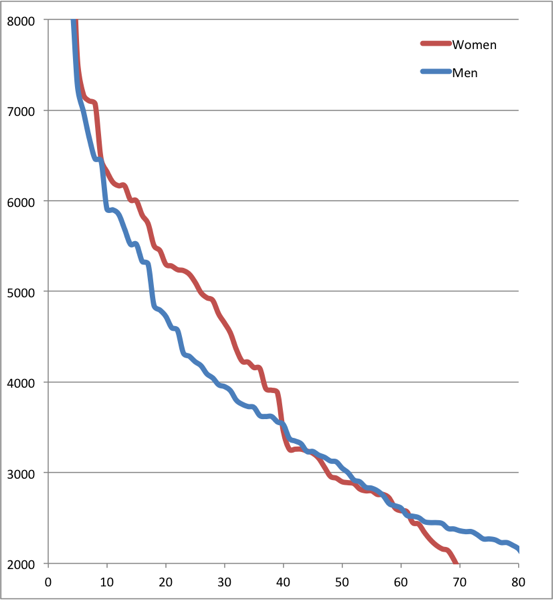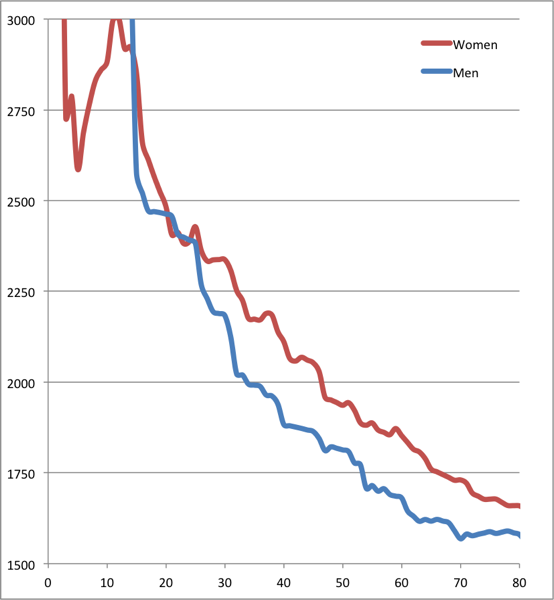The interest into the first round of KPR cutoffs at the end of July is increasing. After having a look at the start lists for the last two races (Lake Placid and Switzerland on July 28th), here is an analysis of what the situation looks like and where I expect the cutoffs to occur.
Men
For the men, there are 40 July qualifiers. At the end of last year, I estimated the July cutoff to occur at 4.000 points.
There will be at least one extra spot with Crowie being an automatic qualifier. (Macca, the other past champion sits in #70 with 2.450. He gets a Kona spot, but doesn’t “move the line”.) It is not 100% clear how the 70.3 champion (Sebastian Kienle) is handled, but I assume that he also does not count against the number of July qualifiers. This means that the cutoff will probably occur at #42 – currently Chris Legh at 3.420 points.
For Lake Placid, these are the athletes close to qualifying:
- Andy Potts: 5.850 points (but still has to validate)
- Tim Van Berkel: 3.610 points
- Ian Mikelson: 3.325 points
- Andres Castillo: 3.280 points
I’m assuming that each of these athletes should be able to move to at least 3.800 points. (It would require Andres to finish in #5 or higher.)
A few of the athletes on the Switzerland start list should be safe already:
- Petr Vabrousek: 5.520 points
- Ronnie Schildknecht: 4.225 points
- James Cunnama: 3.905 points (I don’t think he’s planning to race in Zurich so soon after Roth, it’s probably just a precaution in case he feels his Kona spot is in danger.)
As Switzerland is a P-2000 race, a few more athletes have a chance to get enough points:
- Cyril Viennot: 3.380 points
- Marko Albert: 3.235 points
- Ben Cotter: 3.170 points
- Mike Schifferle: 2.840 points
- Michael Wetzel: 2.530 points
- Simon Cochrane: 2.505 points
In order for Michael or Simon to move to 3.800 points, it would require a 4th place finish – a tall order. Mike would need a top 8 finish. This means that probably three athletes from Lake Placid and four athletes from Switzerland would move to 3.800 points or move. This would move the cutoff to the athlete currently ranked #35 – Marino Vanhoenacker with 3.720 points.
There are 10 more spots at the end of August. At the start of the year I estimated the August cutoff to occur at 4.400 points. With the July cutoff being a bit lower, the number of points required at the end of August will probably also be lower – probably 4.200 will be sufficient.
Women
For the women, there will be 28 qualifiers at the end of July. It will actually roll down to #31, as there are two automatic qualifiers that don’t count (Leanda and Rinnie) and Kelly Williamson (currently sitting on #25) is not interested in racing Kona this year. Right now, #31 is Sarah Piampiano with 4.530 points.
There are no athletes on the Lake Placid start list that is able to reach close to that number of points: The athlete with the most points is Jennie Hansen with 3.240 points, but Lake Placid only offers 1.000 points to the winner.
Switzerland is a P-2000 race, and there are a few athletes that should be able to make the necessary number of points:
- Erica Csomor: 4.750 points, should be able to improve on that (provided she starts)
- Charisa Wernick: 4.360 points
- Sara Gross: 4.230 points
- Rebecca Hoschke: 4.150 points
Each of these athletes should be able to make the top 8 which would give them at least 1000 points and move them well beyond 5.000 points. This means that the last athlete to qualify in July should move four spots to the athlete currently in #28, which is Amy Marsh with 4.900 points.
There are a few athletes in Switzerland with outside/theoretical chances of qualifying:
- Stephanie Jones: 3.160 points
- Regula Rohrbach: 2.800 points
However, if they want to have a chance of qualifying in June, they would have to win the race which seems quite unlikely.
Seven more athletes will qualify at the end of August. Typically, the number of points needed to qualify at the end of August was lower than at the end of July. At the start of the year, I was estimating this cutoff to occur at 4.000 points. As the July number should be about 400 points higher that what I estimated, the August number will probably move by a similar number – to about 4.400.


